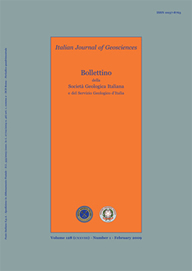
Quaternary evolution of the Pecora River (southern Tuscany, Italy): paleohydrography and sediments provenance
Marco G. Benvenuti(*)(**), Marco Benvenuti(*), Pilario Costagliola(*) & Giuseppe Tanelli(*)
(*) Dipartimento di Scienze della Terra, Università di Firenze, Via La Pira, 4 - 50121 Firenze. Fax: 055.284571; Tel.: 055.2757516; E-mail: marcob@geo.unifi.it
(**) Istituto CNR di Geoscienze e Georisorse, Via La Pira, 4 -50121 Firenze
Volume: 128 (2009) f.1
Pages: 61-72
Abstract
he catchment of the Pecora River is located between the towns of Follonica and Massa Marittima (Southern Tuscany, Italy) and is characterized by Neogene-Quaternary strata resting unconformably on a pre-Neogene substratum. A critical geological re-interpretation of this area indicates that the Quaternary succession, composed by a relatively thin veneer of terrigenous deposits and by calcareous tufas, is the result of five major stages of drainage reorganization. The data from this study indicate that, similarly to present, the paleo-catchment of the Pecora River included the Arsenti Mount area, located few km eastward from Massa Marittima, and that was constantly separated from the nearby Bruna River.
This new re-interpretation of the Quaternary evolution of the Pecora River area has several implications, in particular on the nature of the arsenic anomaly known in this area and mainly confined to the fluvial terrigenous deposits. Specifically, the erosion and dispersal of As-bearing mineralization emplaced between the late Pliocene and the Quaternary in fractures and faults affecting the bedrock of the Arsenti Mount area, was possibly driven by the sedimentary development of the Pecora River catchment resulting in the landforms and deposits described in this study. As a consequence, the As anomaly known in this area may have resulted from fully natural phenomena such as relief denudation and sediment dispersal.
Keywords
Get Full Text